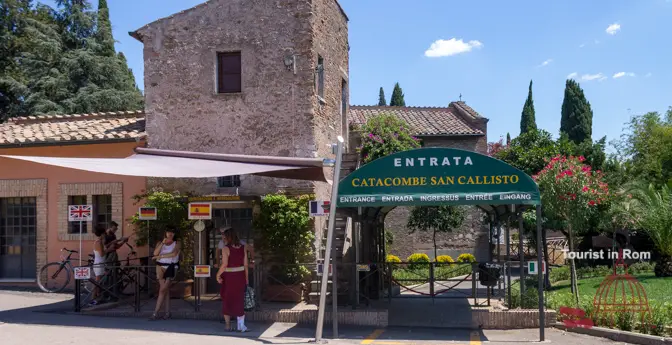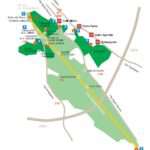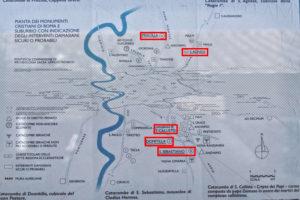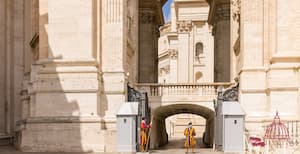Catacombs are everywhere in Rome outside the city walls, but the most famous are the catacombs on the Via Appia Antica.
The Roman catacombs are very interesting and fascinating. You descend into the world of the dead and discover ancient tombs and columbaria, frescoes, prayer rooms and workshops.
Besides, the temperature in the catacombs is quite constant all year round. On hot summer days, a visit to the catacombs is also an opportunity to cool off a bit.
The catacombs on the Appia Antica
In ancient Rome, the dead could only be buried outside the city walls. Therefore, there are tombs and catacombs everywhere along the ancient streets and even today facilities are being rediscovered.
A popular burial ground was the Via Appia and so even today you can walk past tombs large and small, and there are three large catacomb complexes with guided tours in different languages.
All three catacombs are easily reached by bus 218 from San Giovanni to the Fosse Ardeatine stop. The entrance to the Catacombs of Calixtus is just across the street from the stop, and through the park you can also walk to the Catacombs of St. Sebastian. The catacombs of Domitilla are a little way up Via delle Sette Chiese.
The catacombs of St. Calixtus
These second-century catacombs became the official cemetery of the church at the beginning of the 3rd century, and the administration was transferred to the deacon Calixtus by Pope Zephyrinus.
The catacombs of St. Calixtus are closed on Wednesdays.
The catacombs of Saint Sebastian
In this originally pagan plant, St. Sebastian is buried. The catacombs and the basilica are named after him. The entrance to the catacombs is at the basilica.
The catacombs of Saint Sebastian are closed on Mondays and Tuesdays.
The catacombs of Domitilla
They are named after Flavia Domitilla. She was the owner of the land, which was made available to the Christian community in the 1st century AD. Here is the largest Christian catacombs plant in Rome.
The catacombs of Domitilla are closed on Tuesdays.
The Jewish catacombs
The Vigna Randanini catacombs are the second of a total of six Jewish grave sites in Rome. They were built in several phases between the 2nd and 4th century AD and were accidentally rediscovered in 1859. Due to the good state of preservation and the numerous paintings of various objects from pagan and jewish times as well as the numerous inscriptions, they are unique in the Mediterranean. The Vigna Randanini catacombs are not open to the public and can only be visited by appointment in a guided tour.
The catacombs of Vigna Randanini
By Martina Kliem, from the book “Rom für Fortgeschrittene”
Let’s come to the fantastic Jewishs catacombs at number 119. Again, it is important to register in good time – preferably already from Germany. The tombs were discovered in 1859 and date back to the 3rd century. Unique in its kind – at 720 square meters at a depth of ten meters niches, burial chambers and frescoes with Jewish symbols and motifs are distributed. And the Kokhim, the sliding graves that characterize the Jewish culture. They originated as early as the second century, and it is even thought that they were the model for all subsequent catacombs.
(From the chapter “Der Regionalpark der Via Appia Antica”)
The dress code in the catacombs
The catacombs in Rome are sacred sites. In memory of the dead, access is allowed only with presentable clothing. Shoulders and knees must be covered.
Via Appia Antica in Rome
The most famous section of via Appia Antica is in Rome, which can be crossed over a length of 8.7 miles from the start at the gate Porta di San Sebastiano (Museo delle Mura) until to the village of Santa Maria delle Mole. It is located in the regional park of the Appia Antica.
How to get to Appia Antica
Bus route 118 continues from Piazza Venezia to the infopoint of the park office and past the catacombs of Calixtus and Sebastian to the Villa dei Quintili. Bus line 218 runs from the Basilica San Giovanni to the Infopoint of the Park Office and via Via Ardeatina to the Divino Amore sanctuary.
Brief history of the catacombs in Rome
The catacombs go back to a pre-Christian Italic tradition.
While the dead dead cities or cemeteries (necropolis) along the roads outside the city walls were buried in ancient Rome, the underground burial prevailed in the first centuries after Christ. Because land prices were high, was excavated in the depth and’s catacombs have been created, in which not only the dead were buried; Ceremonies were also held and the manufacturer of the sarcophagi had their workshops there.
Space was provided first by individuals for Christians and Jews burials. Soon it was not enough, and then the bones came into catacombs, which gradually developed. They belonged first to burial societies, later they became installations of public law.
The catacombs in Rome were used as cemeteries until the 5th century and served as a place of worship of the martyrs until the end of the 8th century.
With the invasion of the Goths and Langobards in Italy, the bones of the martyrs and saints in the catacombs were no longer safe and were therefore transferred to churches.
The Roman catacombs were subsequently forgotten and only discovered again in the 15th century. This resulted in a very lucrative reliquary, with bones found in the catacombs being sold all over the world.
Representation of Piranesi

The engraver Giovanni Battista Piranesi tells us in a engraving from 1756 his idea, as it once could have looked on the Via Appia. From such a large mass of buildings, however, larger remnants would probably be recognizable today. On the other hand, it looks similar at the Monumenal cemetery Verano, although not so densely packed.
More about the Vatican






